The World’s Longest sea cross Bridge/ tunnel at 55 kilometers. Chinese new year 2018 with the Global Stars are part of the celebrations flying over and around the bridge. HKMZ bridge.
There is a gentle swell this evening as the South China Sea tries it’s very best to rock everyone on board this hydrofoil to sleep. Almost unnoticed we slipped away from Hong Kong Island on the dot of eight for the journey to Zhuhai and mainland China; a journey that for millions, has been a routine inconvenience of an hour or so. Out there, way across the night, is only the vaguest outline and suggestion of a structure, but the lights on the road deck are something of an introduction to a bridge that has cost around $15.9 billion and been eight years in construction. The new bridge from Hong Kong to Zhuhai and Macau across the Pearl River Delta will bring flexibility and reduce journey times considerably.
The Global Stars Aerobatic Team have come as ambassadors of UK aviation to celebrate the Chinese new year by flying around the bridge with pyros on the aircraft. Only a few close friends and relations have any idea of the enterprise that is about to unfold. In the two weeks running up to Christmas four high performance aerobatic aeroplanes were taken apart, loaded two to a container, and shipped by road from Gransden to Hamburg for a rail journey as part of the “New Silk route” to China. The sea option would be at least six weeks, and that boat had sailed. With Visas for pilots still valid from 2017, and flight tickets booked without delay, the response time was nothing short of miraculous!
 Mr Branson’s Virgin Dreamliner has noise so well sorted that it’s almost picture and no sound as we depart 09 Right at Heathrow. A Great Circle route takes in Russia and Mongolia, for another Great British legacy, Hong Kong Airport. A light meal is followed by the boat trip to Zhuhai, short taxi ride, bag drop, couple of beers, sleeping pills for some and jim jams.
Mr Branson’s Virgin Dreamliner has noise so well sorted that it’s almost picture and no sound as we depart 09 Right at Heathrow. A Great Circle route takes in Russia and Mongolia, for another Great British legacy, Hong Kong Airport. A light meal is followed by the boat trip to Zhuhai, short taxi ride, bag drop, couple of beers, sleeping pills for some and jim jams.
The team often hit the ground running, getting off the aeroplane and going straight to the containers. This will not happen for a day or two, as snow “on the line” has delayed the arrival of the aeroplanes. The hotel overlooks the heliport and its 500-metre hard runway, so the team take time for a nosey round. Eventually, a meeting is convened with the television crew, police and local government. Everything we see of Macau en route has been built-in the last five to six years: everything! The pilots have put together ten scenarios with story boards, and after some minor tweaks, return to the hotel through busy rush hour traffic, which oddly enough in China seems to keep moving!
 We’re on the bridge, and the scale is incomprehensible! It is a Leviathan! A stop-watch, a small mass and some school physics reveals that the top of the road deck is four seconds, or roughly eighty metres above the water!
We’re on the bridge, and the scale is incomprehensible! It is a Leviathan! A stop-watch, a small mass and some school physics reveals that the top of the road deck is four seconds, or roughly eighty metres above the water!
Story boards and camera positions, are revisited. A drone will work well, however a helicopter is easier to spot in a hurry. A motor boat will also provide an interesting perspective. We take a ride most of the way to Hong Kong, to the mouth of the tunnel that will allow the larger shipping to pass through the area. Each of us has their own thoughts about the project, but common to us all must surely be a sense of awe at the talent, audacity and imagination of the young men and women that had the confidence and competence to conceive and build this new and unprecedented wonder of the modern Industrial world.
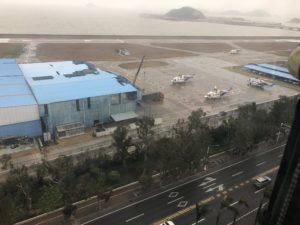 Pilots and engineers wait patiently for news of the containers. Snow has been trumped by smog to the North, and motorway traffic is at a standstill. With their usual stoicism the team plan for an intense period of building that will include wiring up two pyro systems and a partial wrap on a 300L. We’re joined by two technicians from Malaysia who have two days to complete the wrap before heading off to Japan.
Pilots and engineers wait patiently for news of the containers. Snow has been trumped by smog to the North, and motorway traffic is at a standstill. With their usual stoicism the team plan for an intense period of building that will include wiring up two pyro systems and a partial wrap on a 300L. We’re joined by two technicians from Malaysia who have two days to complete the wrap before heading off to Japan.
The time base for this narrative is audible at meal times thanks to a short loop of background music. Adele again, and something incomprehensible about pavements. “Morning, you’ve just missed Adele.”
“Don’t worry, I’ll catch her next time round.”
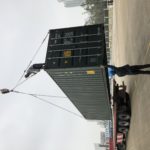 Finally, Mark announces that our Eagle has landed, and the team catch sight of an olive-green container in the entrance to the heliport. Minutes later a crane and a troupe of high wire artistes, “The Flying Patronis,” arrive, offload the containers and open the doors. The contents are still intact: This is not a given!
Finally, Mark announces that our Eagle has landed, and the team catch sight of an olive-green container in the entrance to the heliport. Minutes later a crane and a troupe of high wire artistes, “The Flying Patronis,” arrive, offload the containers and open the doors. The contents are still intact: This is not a given!
Fuselages, wings, tools and spares rather than single malt are unloaded like a scene from Whiskey Galore. Fast forward now to ten past three, the arrival of container two, and repeat the process with the Extra 260 and the borrowed Extra 300L.
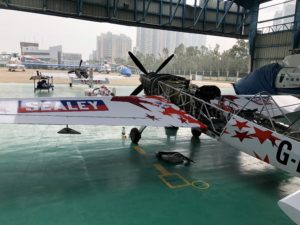 By tea, dinner, supper (delete as appropriate) time we have two machines looking vaguely flyable, and two in bits. Mark runs his just to make a racket.
By tea, dinner, supper (delete as appropriate) time we have two machines looking vaguely flyable, and two in bits. Mark runs his just to make a racket.
Sunset is at six minutes past six, so we go outside to look at the visibility. At this latitude the sun plummets below the horizon, and darkness comes quickly. Back at the hotel we have a “black ‘un” which is Northern colloquial slang for having a beer in one’s dirty filthy working attire before dressing for tea! On this occasion though, we eat in our dishevelled state before heading down for a shower and jimmies.
The General cometh. Our meeting to discuss the flying programme with him is scheduled for two thirty, (stop that tittering at the back Muttock!) The International airport at Macau will be closed for the thirty minutes while we’re airborne, so we need to look the part. Pilots shed their tatty working attire for flying suits becoming not so much the Mercury Seven, as the “Zhuhai Four”.
After a prolonged session of introductions and paroxysms of hand clapping the meeting gets under way, before fragmenting again. Separation from other aircraft (Macau and Hong Kong airlines) takes us well into the second hour; and we have the additional burden of the camera team’s helicopter being 300 metres or so higher than the Extras. Vertical separation is tricky, so we advocate lateral separation by taking a coastal route to each site. Six scenarios are outlined by Mark, with the help of translators.
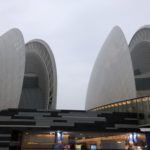 Day-one will see the team fly three times, at eight thirty, ten o’clock and six in the evening. The first two sorties will take place around two local bays between 50 and 500 feet above sea level. Formation flying is a perishable skill, and after several months without regular practice the team need Mark to take them through some spirited turn reversals and formation changes by way of a warm up. By lunch time everyone is smiling!
Day-one will see the team fly three times, at eight thirty, ten o’clock and six in the evening. The first two sorties will take place around two local bays between 50 and 500 feet above sea level. Formation flying is a perishable skill, and after several months without regular practice the team need Mark to take them through some spirited turn reversals and formation changes by way of a warm up. By lunch time everyone is smiling!
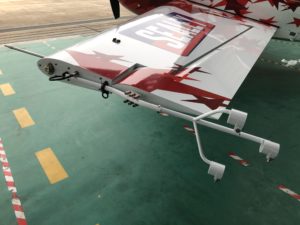 At four the team reconvene like Catesby and Fawkes to assemble pyros and wire them to the aircraft’s electrical system. The Extras now have smoke, pyros and fuselage LED’s
At four the team reconvene like Catesby and Fawkes to assemble pyros and wire them to the aircraft’s electrical system. The Extras now have smoke, pyros and fuselage LED’s
Sunset is at 18:11 and in accordance with the permission granted by the Military, last landing is at 18:30. A time line constructed in reverse provides a schedule; and Mark has a list of targets to achieve at successive minutes past the hour. Everything must be done in one, or at most two takes. 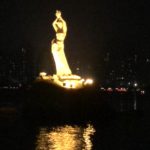 After departure a short sequence with dotty smoke and lights is flown before the pyros are lit. All goes well, including working around a comms failure. Landings are well separated, and approach speeds are much lower than usual due to the short runway: Lots of power against drag. With the last man down all four team back track to the hangar for the first of a series of debriefs. A little disappointing, but a lesson well learned: make the plan more resilient to radio failure.
After departure a short sequence with dotty smoke and lights is flown before the pyros are lit. All goes well, including working around a comms failure. Landings are well separated, and approach speeds are much lower than usual due to the short runway: Lots of power against drag. With the last man down all four team back track to the hangar for the first of a series of debriefs. A little disappointing, but a lesson well learned: make the plan more resilient to radio failure.
Day two’s ten o’clock meeting. Daylight photo opportunities at two coastal landmarks, two bridge scenarios, and a third “bonus” shot.
Two and a half hours later, and everyone, team, helicopter crew and drone operators say they know what they have to do. This is not always an accurate summary of the situation. With about forty minutes to go the pilots walk through the half hour flight wishing there were more than thirty minutes in half an hour. The helicopter crew depart first, into the hover and film the Extras as they depart in pairs, before heading over to the “Clam Shells”, a massive architectural wonder a few miles up the coast. The team are filmed running in underneath the helicopter for a break with the building as background. 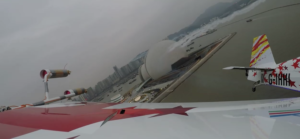 A quick re-join into line astern, along the beach below the level of the hotels to a statue for a “Dirty side” pass, change to diamond, before making for the bridge.
A quick re-join into line astern, along the beach below the level of the hotels to a statue for a “Dirty side” pass, change to diamond, before making for the bridge.
 The team dry run both scenarios with dotty smoke, making time to fit in the third before shooting for real. In the first they’ll fly a curving descending pass close to the first tower, down below the road deck, before pulling up to show top side to the second tower. Scenario two has the team change to “Swan” before Mark peels off to position for the roll around Steve and the two Chris’s in “Vic” at road deck height. The bonus ball is a fly through between the towers in diamond with Chris leading again and Mark in “Box”.
The team dry run both scenarios with dotty smoke, making time to fit in the third before shooting for real. In the first they’ll fly a curving descending pass close to the first tower, down below the road deck, before pulling up to show top side to the second tower. Scenario two has the team change to “Swan” before Mark peels off to position for the roll around Steve and the two Chris’s in “Vic” at road deck height. The bonus ball is a fly through between the towers in diamond with Chris leading again and Mark in “Box”.
There could not have been a greater contrast to the results of the previous evening. The “rushes” are outstanding: All we need now is more good weather.
A mid-morning briefing turns a bit fluffy by five thirty, so the team brief and re-brief to make sure the detail is engrained.
Today’s scenario will require Mark to lead the four Extras across the city close to some impressively tall buildings while co-ordinating with Macau Approach. Departures off Runway 16 will continue away from the action. After that, it’s back to the bridge.
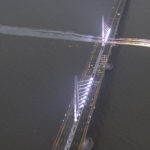
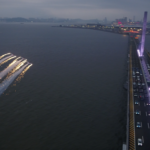
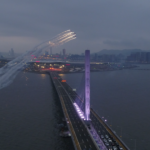 Drone footage on day two was outstanding. The drone, however, was not where the operator said it would be, so we had a bit of a chat. The helicopter team have never filmed aircraft in flight before, and with a maximum speed of around 100 knots, are cause for concern. The camera team learn quickly however, do their very best, and no one has any scary moments.
Drone footage on day two was outstanding. The drone, however, was not where the operator said it would be, so we had a bit of a chat. The helicopter team have never filmed aircraft in flight before, and with a maximum speed of around 100 knots, are cause for concern. The camera team learn quickly however, do their very best, and no one has any scary moments.
The weather today is grey, overcast and hazy, so any long-distance footage is unlikely to better that of the previous day. A very tidy pairs departure is quickly followed by a frequency change to Macau Approach; and as the formation races low across town, nothing could be too much trouble. The sortie goes well, and there will be some useable material, but this will not reflect the amount of effort that has gone in to it. Just one more day to complete the filming.
This time last year the team were in India, at Vijayawada. Flying two or three times a day. This helped us prepare for the World Formation Aerobatic Championships in April. Here in Zhuhai, we can only fly at sunset so plenty of time for house-keeping. Our despatch reliability is very impressive. Flying to a strict schedule in twilight is obviously not so forgiving as darkness arrives very abruptly here.
 Today’s two scenarios include a return to the Clam Shell shells to re-shoot the break with drone and helicopter, another take on the two hearts, and finally, a run towards the bridge with a fan break, up and over the towers while rolling!
Today’s two scenarios include a return to the Clam Shell shells to re-shoot the break with drone and helicopter, another take on the two hearts, and finally, a run towards the bridge with a fan break, up and over the towers while rolling!
The Extras are lined up outside the hangar for team photographs, and spirits are high. Strapping in with life jackets and parachutes can be a bit of a faff, so with twenty minutes to go each pilot goes through their own little routine like left sock on before right. Strapped in, you can then just let your shoulders drop a little and visualize the next forty minutes from start up, check in SOP, taxi, take off, form up and so on. Perhaps run through a few what ifs: what the airlines delight in calling TEM, or “Threat/Error Management”. Threats come at you, and errors come from you etc.
Ten minutes to take off, canopies come down, time to go. Only three engines start thanks to a faulty starter solenoid. Mark re-briefs everyone while back tracking the runway.
Two weeks ago, we were asking ourselves “what do they want to see?” “How will they film it?” Filming is now complete. The Global Stars have had the unique privilege of standing on and participating in the opening of the world’s longest bridge.
In the next two days, we are going to play the film backwards as four aeroplanes are stripped and made ready for the wings to be lifted off. This is a rite of passage that requires a certain amount of chuntering, nosing around and approval from a High Priest, that yes, your wing is good to go! Embarrassed is the one who drags everyone over for the lift, only to find that a canopy latch or an earth lead is still attached: No one says anything, but the body language says it all. “Sorry!” Apologies are futile! By tea time we’re ready for the containers.
On day two, along with tools and spares, we shoe horn two aircraft back into each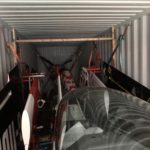 container. There are also the High Priests of strapping in. They’ll ratchet wing stands to the sides of the containers, before tackling the fuselage. Should the tyres deflate, the aircraft will sit suspended in mid-air: all very clever!
container. There are also the High Priests of strapping in. They’ll ratchet wing stands to the sides of the containers, before tackling the fuselage. Should the tyres deflate, the aircraft will sit suspended in mid-air: all very clever!
Finally, the doors are locked, the containers are ready to go; and the next time we’ll see one is at Gransden. The other goes North by road to Zhengzhou. We’ll be back to China to see that one again in April.
We, on the other hand, are homeward bound in a little over twenty-four hours. The ferry to Hong Kong, an overnight to London, and pick up where we left off just over two weeks ago. Who knows, next time we might take the bridge.
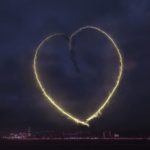 The astronaut Jim Lovell told us that in NASA they identify three groups of people. Some people make things happen, some watch things happen, and some ask “what just happened?” Taking four or more aeroplanes, a team of pilots and engineers 5000 miles or more from home to an event like this, and bringing everyone home safely requires something special from those individuals; the ability to get on with people, to work along-side them, to cope with failure: In short, to be “tough and competent”.
The astronaut Jim Lovell told us that in NASA they identify three groups of people. Some people make things happen, some watch things happen, and some ask “what just happened?” Taking four or more aeroplanes, a team of pilots and engineers 5000 miles or more from home to an event like this, and bringing everyone home safely requires something special from those individuals; the ability to get on with people, to work along-side them, to cope with failure: In short, to be “tough and competent”.


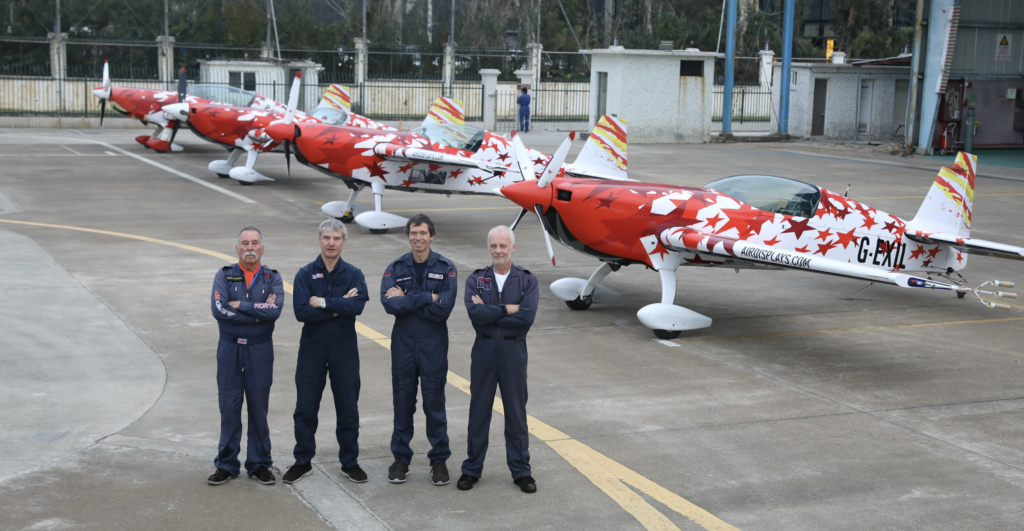
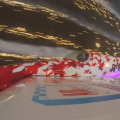

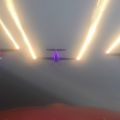
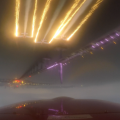
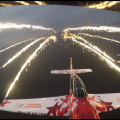

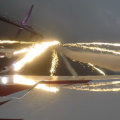

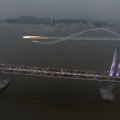
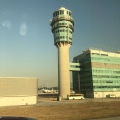


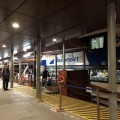
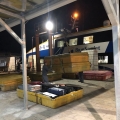
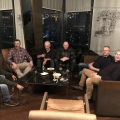
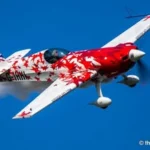

 WhatsApp me
WhatsApp me
You must be logged in to post a comment.